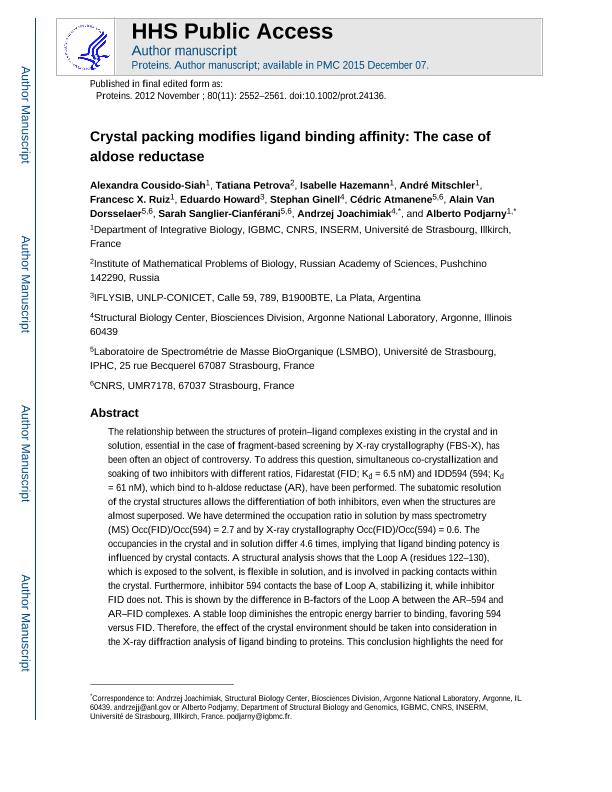Mostrar el registro sencillo del ítem
dc.contributor.author
Cousido-Siah, Alexandra
dc.contributor.author
Petrova, Tatiana
dc.contributor.author
Hazemann, Isabelle
dc.contributor.author
Mitschler, André
dc.contributor.author
Ruiz, Francesc X.
dc.contributor.author
Howard, Eduardo Ignacio

dc.contributor.author
Ginell, Stepahn
dc.contributor.author
Atmanene, Cédric
dc.contributor.author
Van Dorsselaer, Alain
dc.contributor.author
Sanglier-Cienférani, Sarah
dc.contributor.author
Joachimiak, Andrzej
dc.contributor.author
Podjarny, Alberto
dc.date.available
2019-09-11T17:37:34Z
dc.date.issued
2012-11
dc.identifier.citation
Cousido-Siah, Alexandra; Petrova, Tatiana; Hazemann, Isabelle; Mitschler, André; Ruiz, Francesc X.; et al.; Crystal packing modifies ligand binding affinity: The case of aldose reductase; Wiley-liss, Div John Wiley & Sons Inc; Proteins: Structure, Function And Genetics; 80; 11; 11-2012; 2552-2561
dc.identifier.issn
0887-3585
dc.identifier.uri
http://hdl.handle.net/11336/83350
dc.description.abstract
The relationship between the structures of protein-ligand complexes existing in the crystal and in solution, essential in the case of fragment-based screening by X-ray crystallography (FBS-X), has been often an object of controversy. To address this question, simultaneous co-crystallization and soaking of two inhibitors with different ratios, Fidarestat (FID; Kd = 6.5 nM) and IDD594 (594; Kd = 61 nM), which bind to h-aldose reductase (AR), have been performed. The subatomic resolution of the crystal structures allows the differentiation of both inhibitors, even when the structures are almost superposed. We have determined the occupation ratio in solution by mass spectrometry (MS) Occ(FID)/Occ(594) = 2.7 and by X-ray crystallography Occ(FID)/Occ(594) = 0.6. The occupancies in the crystal and in solution differ 4.6 times, implying that ligand binding potency is influenced by crystal contacts. A structural analysis shows that the Loop A (residues 122-130), which is exposed to the solvent, is flexible in solution, and is involved in packing contacts within the crystal. Furthermore, inhibitor 594 contacts the base of Loop A, stabilizing it, while inhibitor FID does not. This is shown by the difference in B-factors of the Loop A between the AR-594 and AR-FID complexes. A stable loop diminishes the entropic energy barrier to binding, favoring 594 versus FID. Therefore, the effect of the crystal environment should be taken into consideration in the X-ray diffraction analysis of ligand binding to proteins. This conclusion highlights the need for additional methodologies in the case of FBS-X to validate this powerful screening technique, which is widely used.
dc.format
application/pdf
dc.language.iso
eng
dc.publisher
Wiley-liss, Div John Wiley & Sons Inc

dc.rights
info:eu-repo/semantics/openAccess
dc.rights.uri
https://creativecommons.org/licenses/by-nc-nd/2.5/ar/
dc.subject
Competitive Binding
dc.subject
High Resolution Crystallography
dc.subject
Ligand Soaking
dc.subject
Mass Spectrometry
dc.subject
Protein Crystallography
dc.subject.classification
Biofísica

dc.subject.classification
Ciencias Biológicas

dc.subject.classification
CIENCIAS NATURALES Y EXACTAS

dc.title
Crystal packing modifies ligand binding affinity: The case of aldose reductase
dc.type
info:eu-repo/semantics/article
dc.type
info:ar-repo/semantics/artículo
dc.type
info:eu-repo/semantics/publishedVersion
dc.date.updated
2019-04-26T18:18:06Z
dc.journal.volume
80
dc.journal.number
11
dc.journal.pagination
2552-2561
dc.journal.pais
Estados Unidos

dc.journal.ciudad
Nueva York
dc.description.fil
Fil: Cousido-Siah, Alexandra. Université de Strasbourg; Francia
dc.description.fil
Fil: Petrova, Tatiana. Russian Academy of Sciences. Institute of Mathematical Problems of Biology; Rusia
dc.description.fil
Fil: Hazemann, Isabelle. Université de Strasbourg; Francia
dc.description.fil
Fil: Mitschler, André. Université de Strasbourg; Francia
dc.description.fil
Fil: Ruiz, Francesc X.. Université de Strasbourg; Francia
dc.description.fil
Fil: Howard, Eduardo Ignacio. Consejo Nacional de Investigaciones Científicas y Técnicas. Centro Científico Tecnológico Conicet - La Plata. Instituto de Física de Líquidos y Sistemas Biológicos. Universidad Nacional de La Plata. Facultad de Ciencias Exactas. Instituto de Física de Líquidos y Sistemas Biológicos; Argentina
dc.description.fil
Fil: Ginell, Stepahn. Argonne National Laboratory; Estados Unidos
dc.description.fil
Fil: Atmanene, Cédric. Centre National de la Recherche Scientifique; Francia. Université de Strasbourg. Laboratoire de Spectrométrie de Masse BioOrganique ; Francia
dc.description.fil
Fil: Van Dorsselaer, Alain. Centre National de la Recherche Scientifique; Francia. Université de Strasbourg. Laboratoire de Spectrométrie de Masse BioOrganique ; Francia
dc.description.fil
Fil: Sanglier-Cienférani, Sarah. Centre National de la Recherche Scientifique; Francia. Université de Strasbourg. Laboratoire de Spectrométrie de Masse BioOrganique ; Francia
dc.description.fil
Fil: Joachimiak, Andrzej. Argonne National Laboratory; Estados Unidos
dc.description.fil
Fil: Podjarny, Alberto. Université de Strasbourg; Francia
dc.journal.title
Proteins: Structure, Function And Genetics

dc.relation.alternativeid
info:eu-repo/semantics/altIdentifier/doi/http://dx.doi.org/10.1002/prot.24136
dc.relation.alternativeid
info:eu-repo/semantics/altIdentifier/url/https://onlinelibrary.wiley.com/doi/full/10.1002/prot.24136
dc.relation.alternativeid
info:eu-repo/semantics/altIdentifier/url/http://europepmc.org/backend/ptpmcrender.fcgi?accid=PMC4671318&blobtype=pdf
dc.relation.alternativeid
info:eu-repo/semantics/altIdentifier/url/https://www.ncbi.nlm.nih.gov/pubmed/22752989
Archivos asociados
